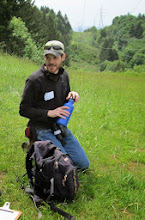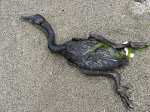Before the heat wave, Sarah and I spotted another Anna's Hummingbird nest in another small oak.

Two days later, I spotted one of the nestlings a few inches from the nest.
Today the rain returned and I noticed the annual arrival of European starling fledglings.

For weeks, we could hear begging nestlings calling from the nooks and crannies in houses and other buildings. Now, small brown fledglings follow their parents, begging for whatever food items they pull out of the grass. Like my beloved cicadas, the starlings seem to perfectly synchronize the emergence of their young.

Biologists believe that cicadas, seen above, emerge en masse to swamp predators and decrease an individual's likelihood of being eaten. Perhaps starlings evolved their synchronicity for the same purpose. One lone, naive fledgling probably has a greater chance of being picked off than one mixed into a flock of fledglings and adults that can better spot and confuse the predator with their escape flights.

Another advantage starling fledglings have is a long, three week nestling period that allows greater development prior to fledging. Unlike other altricial birds, starling fledglings appear to fly as well as their parents. With these adaptations, it's no wonder this species is so successful in its expanded range!
During the rest of the year, I tend to ignore or get annoyed by starlings. During baby starling season, however, I am fascinated by the biology of this neighborhood invader.






1 comment:
Glad you are fascinated by the Starlings. I am more annoyed than ever. I hate their little buzzy cries. Darn birds!
Post a Comment